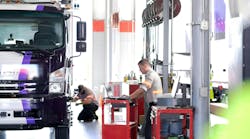The Road Information Program (TRIP), a Washington, D.C.-based nonprofit research group, said its review of recently released data from the FHWA 2001 survey of major state and local roads raises major concerns for both motorists and commercial truckers.
While overall travel on urban roads increased by 30% between 1991 and 2001, travel by large commercial trucks jumped 46% over the same time period.
Vehicle travel is projected to increase 42% by 2020, while travel by heavy trucks is expected to climb by 49%, said TRIP.
But road conditions are worsening even as miles traveled increase. TRIP found that nationally 25% of major urban roads are in "unacceptable" condition, 43% have "acceptable" ride quality, and 32% are just in "good" shape. TRIP noted that the FHWA annual study includes a review of interstate highways, freeways and other main routes.
TRIP also said road-repair funding is not keeping up. A 2002 U.S. Department of Transportation (DOT) study prepared for Congress found that urban road and highway pavement conditions are likely to get worse at current funding levels. The DOT study concluded that improving the physical condition and performance of urban roadways would require a 49% increase in annual funding, from $13.6 billion annually to $20.2 billion per year.
The problem, said TRIP, is that driving on roads in poor conditions increases vehicle maintenance costs. TRIP calculated that, on average, motorists in the nation’s major urban regions are paying $396 annually per driver in extra vehicle operating costs to drive on roads in need of repair.
"Without additional federal investment, our nation’s roads are going to get worse and motorists are going to pay a higher 'hidden tax' in the form of additional vehicle operating costs," said William M. Wilkins, TRIP’s executive director.


